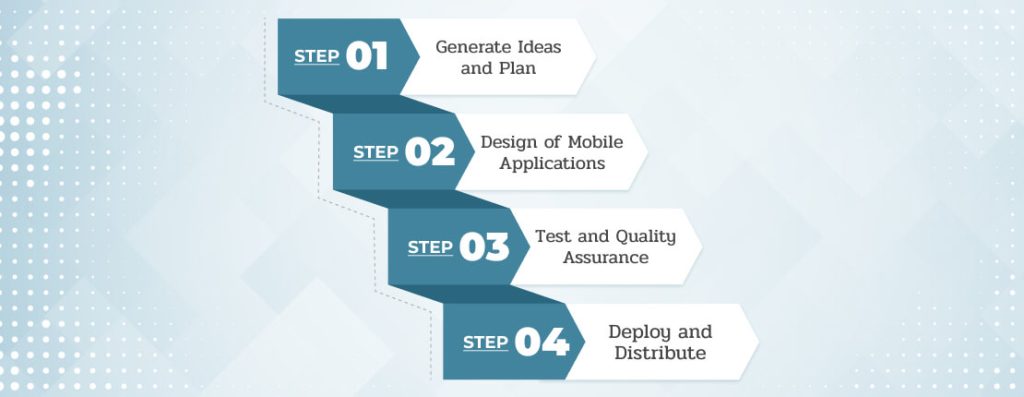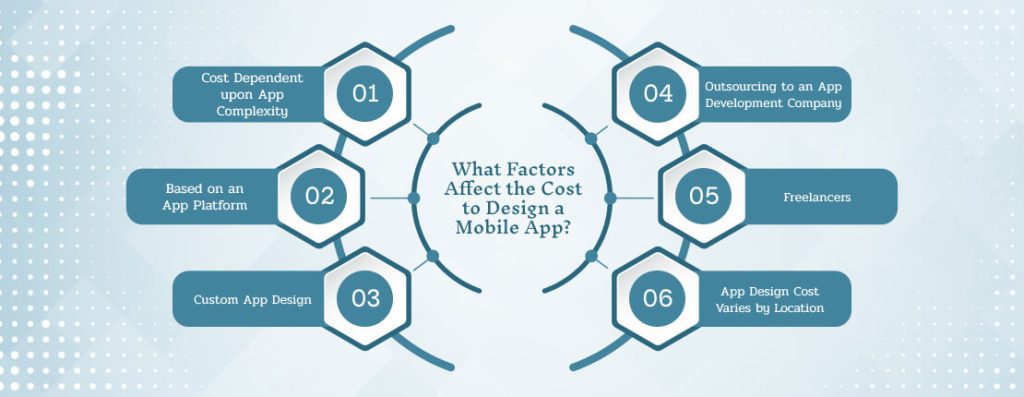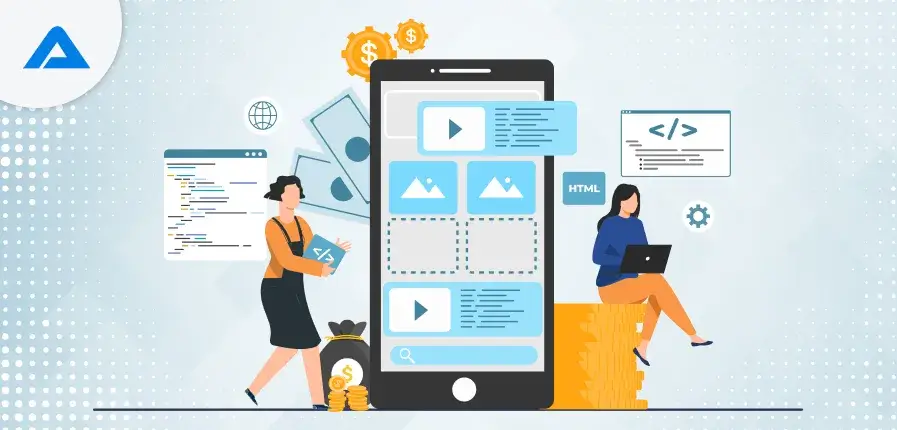Cost estimation for developing mobile applications is essential for businesses. To answer accurately, “How much does it cost to design an app?” First, one needs a basic knowledge of which provides an estimate for creating one.
Developing mobile applications is a complex and laborious task requiring various tools. When developing apps for phones, we first must consider both design considerations and the expenses involved with creating an application. After considering these factors, mobile app design will become the central theme that draws users’ attention—the article below examines these impacts as well as various phases required in the creation process.
The cost of creating apps varies based on factors like screen size and complexity, design team expertise, and physical space constraints. Knowing the design costs associated with developing mobile applications and the expense of creating and making them are equally essential to understanding investment costs in mobile application development. By understanding them, you’ll know just how much is invested.
Cost analysis for app development relies heavily on hourly rates; US developers pay between 100 and 120 per hour, while European app creators may need 50-100 an hour. Final costs can then be determined by multiplying this figure by the duration required to build the app.
What Is Mobile App Development?
Mobile app design refers to creating apps tailored explicitly for portable devices like phones and tablets.
Creativity, technology, and problem-solving skills come together to create practical mobile apps that bring ideas to life. Companies investing in developing these applications will take advantage of all that mobile technology provides and give customers an enjoyable user experience. Apps can be downloaded directly onto devices via the store or even web browsing, but most need an internet connection to utilize remote computers’ capabilities effectively.

Craft Memorable User Experiences with Our Tailored UI/UX Solutions.

Pooja Upadhyay
Director Of People Operations & Client Relations
What Types of Mobile Device Applications Can be Created?
Before considering the cost of app design, it’s essential to understand all of its steps and phases of creation. Every project begins with an idea and can only become a reality through intensive execution and modification.
Native Development
One of the easiest methods of mobile app development is working with platforms and devices offered by OS vendors. These tools are explicitly tailored towards ease of use for user interaction and offer examples of frameworks, tools, and other methods designed to speed testing while making full use of OS capabilities on different mobile devices.
Native development tools do have some drawbacks. Since they were designed to facilitate development for specific platforms and OSs, they rely heavily on tools, programs, and languages particular to those OSes or platforms – meaning people who wish to write code using Android or iOS devices must familiarise themselves with all applicable languages before writing code in their preferred one. Furthermore, making an app compatible with both OS options requires two tasks; two separate projects must be undertaken using different strategies that best meet user needs.
Cross-Platform Development
Cross-platform (also called hybrid) frameworks enable developers to construct mobile applications that run on both operating platforms simultaneously. Ideally, developers only have to write code once for all operating platforms they allow – although many cross-platform frameworks favour one OS over the other, which often necessitates modifications specific to that OS version of frameworks.
Cross-platform development frameworks tend to be abstractions that utilize native frameworks and libraries; developers must be familiar with these tools to use them. Some frameworks employ hybrid approaches by employing both web components and native elements.
Mobile Web App: An Alternative Approach
Another increasingly popular approach to developing mobile applications is employing the mobile web browser as part of the app creation process. This involves creating an online application accessible via standard web browsing before adapting it to mobile devices.
As it may appear to save costs, mobile web apps offer functions, efficiencies, and refinements similar to their native counterparts. There exist various frameworks tailored explicitly to helping developers develop mobile web apps that look and behave similarly when run on specific mobile operating systems; such applications could potentially support features available only through native apps on specific mobile devices (for instance, calling cameras directly) as well as information regarding users locations – among many other capabilities.
Steps Involved in the Mobile Application Development Process

Yet developers could choose different strategies or employ various methods of operation.
Are you planning on building an app, or do you need a competitive advantage within your current company by building the next application? Here are a few key considerations before beginning the development process
Generate Ideas and Plan
Developing mobile applications begins by brainstorming innovative yet practical ideas that meet business goals and needs. This is followed by research, brainstorming, and outlining an app design’s features for its intended target audience and features.
When the concept has been finalized, specific details regarding capabilities, features, and scope must be determined. To demonstrate this planning stage, wireframes, flowcharts, or models of an application’s layout/functionality must be created.
Design of Mobile Applications
Mobile apps depend heavily on visual elements like the User Interface (UI) and the User Experience (UX). Their primary goal is to ensure an app’s navigation is user-friendly while visually appealing to provide an enjoyable and seamless user experience. Designers determine colors, fonts, and visual elements that fit within a brand image that customers appreciate while designing the flow of information for interaction and navigation and ensuring customers effectively complete tasks.
At this step, mobile app developers bring an idea into reality by developing and designing an app from conception to completion. Working closely with designers, they transform user experiences and designs so the app delivers precisely as intended. They use frameworks and programming language/development tools to develop their core functions; adding features, controlling information storage, and writing efficient code are among the responsibilities. Incorporating APIs or third-party apps, including databases, is another aspect developers should consider for the ultimate efficiency of applications.
Test and Quality Assurance
The comprehensive, exhaustive tests and quality assurance (QA) ensure a secure application by helping identify bugs, stakes, or usability problems and correcting them quickly and effectively. Functional testing verifies that features are working correctly, while a performance test for security dependability verification is conducted to test the program’s security dependability on different operating systems/platforms/compatibility. At the same time, user acceptance education collects feedback directly from end users and makes any needed modifications accordingly.
Deploy and Distribute
Now that QA/testing has validated that your application meets the expected quality and functionality criteria, it’s time to plan its distribution and implementation. iOS developers must submit their app through Apple’s App Store, while Android developers can upload to Google Play Store (owned by Google ). PWA hosts its servers, making them accessible from any browser available online.
Developers may submit hybrid applications similar to native apps to storefronts available through PWA for approval and distribution. App developers may distribute their apps via marketplaces or channels dedicated to enterprise apps developed by third-party developers. At the same time, applications created with tools like Apache Cordova or React Native can also be made available as native apps that users can install directly onto devices.
Maintaining and updating mobile app development is an ongoing process; as part of that effort, regular updates and maintenance must keep it operating seamlessly, address any bugs or issues that arise, and add features based on customer feedback and market trend analysis.

How Much Does Building a Mobile Application Cost?
According to StackOverflow’s research study on ways to lower mobile app design costs using cloud-native technology, costs associated with building mobile apps typically fall within the $50,000-$500,000 range. Key elements that influence development costs include:
Complexity of App
A simple app with minimal functions and layout, requires less development time and resources, leading to lower overall costs. Conversely, complex applications that feature interconnection between different systems or custom features explicitly tailored for user requirements often take more resources to create. As a result, costs could rise.
Experience and Design
The costs associated with UI/UX design services, graphics, and visual assets can differ depending on their level of customization and how much is necessary to meet user experience demands. An app appropriately designed will enhance user satisfaction but increase development costs overall.
Building for all devices and platforms: Constructing for iOS and Android requires additional testing and development time and expense. This costs money because your code must work across sizes, screens, and resolutions.
API and Backend Development
Building server infrastructure, database integration, and connecting APIs that must be purchased can be laborious processes requiring special knowledge that could drive up costs considerably in development.
Maintenance, bug fixes, and feature enhancements are necessary components of keeping software secure, up-to-date with technological trends, reliable, safe, and profitable for consumers to use. Unfortunately, they come at a cost.
When seeking cost estimates for developing applications or freelancer projects, reputable companies and freelancers are recommended for the best estimates of costs related to specific tasks you need help completing. In cases where costs are essential to you, low-code apps could reduce costs further, as this would eliminate time-consuming programming steps for development projects.
What Factors Affect the Cost to Design a Mobile App?

However, more complex applications receive less publicity; while they offer many features for users, most prefer more superficial apps in terms of time and effort invested and future modifiability.
Cost Dependent upon App Complexity
Your app’s layout will be developed according to your concept. The level of complexity will depend on the Design, such as the number of screens, layout features, and usability considerations.
Based on an App Platform
As part of app development, developers have two choices when designing apps: build from scratch or use an existing template layout. There are various kinds of applications within each category, and prices will depend upon which platform you select for development; see the table below for further details about types and prices applicable for both Android and iOS platforms – meaning costs related directly to which platform is chosen for app creation can quickly be evaluated.
Custom App Design
A custom app UI design involves handcrafting each element from its inception. Instead of using libraries that already exist as starting points for development, every aspect must be designed from scratch.
Outsourcing to an App Development Company
Working with an app development firm offers several key advantages. They possess in-depth knowledge about the app design process and are more knowledgeable about Design than local design firms and freelancers; moreover, trusted mobile app development firms focus on quality processes and communicative practices than others.
As soon as this occurs, it’s wise to locate and contact a design firm in your locality and explain your branding and design needs. A suitable agency would also hire app developers who could create iOS or Android applications tailored specifically for your company.
Freelancers
Utilizing freelancers is often the least expensive solution available; however, take time to clearly articulate your expectations to avoid unintended results. Below, you’ll find a table that summarizes the benefits and drawbacks associated with hiring freelancers to design an application.
App Design Cost Varies by Location
Alongside app complexity, hiring designers from within a specific country is also crucial when hiring app designers for development services. If you live in America and need designer assistance, it may be cheaper and faster to employ an Indian-based team than an American firm because app development companies tend to charge quite expensively for app development services. The USA.
How Can We Reduce Mobile App Design Prices?
Mobile app development can cost thousands of dollars, and without proper guidance and direction, a budget could easily surpass expenses. Thus, making informed decisions and investing wisely could reduce the costs of developing apps while creating highly efficient, mobile-friendly ones.
Before Starting App Development
As soon as you decide to create an app, an image of its final form will likely come into your head. From Design through development and beyond, your app could undergo many transformations that could change perceptions about it; to avoid this happening and prevent disagreement among its creators from emerging, make a prototype release document (PRD). You may contact our team of app developers about making one and communicating through it directly.
Prototype Creation Is Key for Reducing Costs
Establishing prototypes is an integral component of creating applications. Prototypes allow you to visualize the final look and function of your website more clearly, reduce development times, and save money! When investing in making prototypes, you will reduce the time required from web developers and money costs!
Outsourcing App Development to Reduce Design Costs
At all, cost-cutting efforts are paramount to business. When developing applications with mobile-friendly designs and functionality, reducing development expenses while remaining fully functional can be particularly crucial. Hiring internal employees tends to be more costly than deciding to hire professional UI/UX designers from experienced app development firms.
Build and Examine Features in an MVP App
Direct investment into fully functional products could be risky; however, an MVP might prove helpful. By creating this solution for yourself and testing only essential features of iteration one, an efficient program would consist of less complex versions with key functionality demanded by those you intend to target as target audience members.
Use an Already Existing System Instead of Building One
Develop Your App Without APIs Or Libraries The cost of developing your functionality without using APIs or libraries from third-party libraries can skyrocket, making the development more expensive than necessary. Therefore, to reduce expenses, select well-known and reliable apps that fulfil all the requirements for your mobile app, such as third-party firms specializing in every imaginable function; they make finding and incorporating components easier, reducing overall development expenses significantly.
Conclusion
The cost of developing apps depends on various factors, including their complexity and capabilities, the time needed for their creation, and an estimate for market research on competitor developments to create helpful product products. Although an exact figure cannot be given as to the cost of producing such an app, knowing these aspects gives an approximate idea of what you may expect when designing applications.
An efficient app design plays a pivotal role in its overall performance, so conducting a thorough market analysis provides the necessary intelligence for an outstanding final result. Yet, the most important consideration when designing applications is cost consideration: the cost of creation must also factor heavily into the equation.
App design development costs vary significantly based on project complexity, extent, client needs, and objectives. Design/technical aspects and exploration phases all play into this cost calculation. Prices for apps vary between markets, allowing you to choose what best meets your requirements. Be mindful that costs can always be minimized by cutting expenses as part of this process.

Ready to Impress Your Audience? Hire Our Web UI/UX Designers for Outstanding Results.

Pooja Upadhyay
Director Of People Operations & Client Relations

